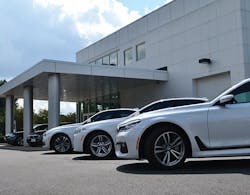BMW’s Run-Flat Tire Philosophy: ‘We Don’t Want to Mess With Something That’s Working’
BMWs are far from the best-selling vehicles in the U.S. Halfway through 2016 BMW sales amounted to not quite 2% market share with a little more than 153,000 vehicles sold, according to statistics compiled by Good Car Bad Car.
Still, that relatively tiny segment of new car sales is a driver for an entire category of tire technology: run-flat tires.
The German luxury brand has been a leader in the use of run-flat tires. “We’re at the forefront of bringing this in the U.S. and really taking on the challenges of the misconceptions in the industry about why certain people would prefer non-run-flats versus run-flats,” says Jose Guerrero, product manager for BMW i, BMW M, BMW Individual, and BMW Alpina. “We feel strongly that the run-flat solution for many of our drivers makes sense.”
And that’s why run-flat tires are the standard on nearly every BMW vehicle sold in America. The only exceptions are the automaker’s electric vehicle line, the BMW i, and its motorsport line, the BMW M. On the BMW i the heavier weight of run-flat tires reduces the vehicle’s range, and the company doesn’t yet have large enough batteries to offset the drag from that weight, Guerrero says. As for the BMW M, those drivers are looking for performance on the track, and they instead opt for more performance-driven tires. “But those are the minority of our sales. Those are exceptions.”
Otherwise, Guerrero says run-flat tires rule. “All cars, all platforms, all series have a run-flat slot and they’re typically standard. But what we have are options. Especially in our most popular sizes there’s a requirement that it has to have a run-flat, and a non-run-flat with a spare. But the take rates for those non-run-flats are very small. Most BMW customers appreciate the service of run-flats and they leave it alone.” Guerrero says run-flat tires are a good fit for what he calls the BMW experience.
“We always try to put ourselves in the seats of our customers. We know that when something goes wrong, when there is tire damage of some sort, asking a BMW driver to pull over and, sometimes at the most inopportune times, change their own tires, is not a premium experience,” Guerrero says. “Purchasing a BMW you have a certain expectation of quality and an overall premium experience, and that’s where changing a tire falls flat right there. We really try to look at what services need to be around for our customer when things go wrong.”
That’s why run-flat tires are part of a two-prong service. BMW’s connected driver service, called BMW Assist, gives consumers an instant connection to an expert who can help the driver determine the severity of the tire damage and whether he can make it to the closest dealership or if a tow truck needs to be called.
Guerrero has first-hand experience with the service. He was driving on a road that was being repaired when he hit something. He admits he was driving “a little too fast” given the road’s condition, but the car immediately notified him he was losing tire pressure. He pressed the BMW Assist button and weighed his options. Did he need to go straight to the nearest dealer, or could he make it home and have a tow truck meet him there? The BMW Assist expert mapped out the distance to Guerrero’s home and determined he could make it if he drove under a certain speed. “That kind of service is different in each situation, but having it with me I felt like I got the premium experience I was expecting from BMW. If I had to change my tires myself, not such a premium experience.”
The common complaints: wear and ride
Premium service aside, consumers do have some issues with run-flat tires. Independent tire dealers are well versed in the most common complaints: not enough tread wear, an uncomfortable ride, and exorbitant replacement costs. There are online forums full of drivers wondering how and if they can or should ditch their run-flat tires for non-run-flat tire options.
Guerrero says BMW has heard those complaints, “especially in the early days.
“What’s important for OEMs like BMW, we design the cars with run-flats from the get-go. It’s not an afterthought or a small option. I think that commitment from OEMs like BMW gets the best possible customer experience. Over time, we’ve seen those types of complaints reduced.”
At the same time, that’s a reason non-run-flat tires remain an option at BMW. “But that’s the minority of people who are putting spare tires in their cars.”
The next evolution of run-flat tires
There’s plenty of room for more advancement, Guerrero says. Performance-oriented run-flat tires, options designed for electric and hybrid vehicles, and fitments for the larger wheel sizes all need to be in the mix. The ongoing push for more efficient vehicles, and thus the need for more efficient tires, extends to run-flat tire options, too. Eliminating the spare tire isn’t enough.
“The run-flat performance for performance cars is something that we’re eyeing,” Guerrero says, even while acknowledging the larger industry is focusing more on efficiency and less on performance. That emphasis is in large part due to CAFE standards. “It’s really pushing tire manufacturers even further to come up with lighter, more efficient run-flat tires because this standard is not going away. It might change. It potentially could be lessened. But at the end of the day it’s not going away.
“We’re at the point now where we’re one of the grandfathers in OEM for run-flat technology. We truly stand up for run-flat technology. We do believe in the safety and benefits of being a premium solution for tire damage with run-flats, so we want to expand that,” Guerrero says.
“We cannot un-train the desire for run-flats,” he says. “It’s pretty simple for us. We know the customers appreciate it and we want to continue offering run-flat tires. We don’t want to mess with something that’s working.”
89 run-flat tire options
BMW sells tires on its website, and allows consumers to choose to have them installed by a dealer or delivered to their home, or the customer can pick up the tires at the dealership. Installation carries an extra cost that’s assessed by the dealer at the time of service.
Jose Guerrero says the online lineup of run-flat tires, 89 options strong, is a comprehensive database of the run-flat tires the automaker offers either as original equipment or a replacement option. The list covers six tire brands: Michelin, Goodyear, Pirelli, Bridgestone, Continental and Dunlop. There are $500 run-flat tires (the Continental ContiSportContact 5 SSR in size 255/40R19 for $522.35) and options around $200 (the Michelin Primacy MXM4 ZP in size 225/50R17 for $205.88.)
Flat tires and no spare
A record number of 32 million motorists called on AAA for help with roadside emergencies in 2015, with vehicles less than five years old experiencing a higher proportion of tire issues than older vehicles. The club says the elimination of the spare tire “may have unintended consequences.” (Keyless ignition systems are another modern advancement creating problems for drivers.)
Of the millions who called for roadside help in 2015, more than 360,000 of those calls were from drivers who didn’t have spare tires, says Mariam Ali, public relations manager for AAA.
Tire problems, along with dead batteries and keys locked inside a vehicle, remain the top prompts for service calls. Tire emergencies typically require putting air in tires or installing the spare tire, Ali says.
In November 2015 AAA called on auto manufacturers to reverse course and bring back the spare tire. At the time John Nielsen, managing director of automotive engineering and repair for AAA, said, “Flat tires are not a disappearing problem, but spare tires are. AAA responds to more than four million calls for flat tire assistance annually and, despite advances in vehicle technology, we have not seen a decline in tire-related calls over the last five years.”
15 years of run-flat tires
The 2001 Lexus SC430 was the first vehicle by Toyota Motor North America Inc. equipped with run-flat tires. Fifteen years later, the vehicle manufacturer says roughly 8% to 10% of all of its vehicles come with run-flat tires. And with continual improvements to the tires, Toyota says it plans to keep using run-flat technology in the future.
At this point, Toyota only fits run-flat tires on coupes and sedans. “Currently many suppliers are researching application of run-flat tires in larger aspect ratio (55 and higher) as used by competitors. Toyota is closely monitoring this segment and evaluating its feasibility,” says Brian Watkins, advanced technology communications analyst for Toyota.
But those large aspect ratios “present a challenge to run-flat tires. As such, implementation for large SUVs and trucks will most likely be limited in the near future.”


